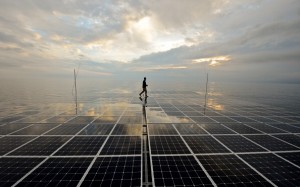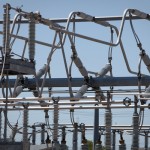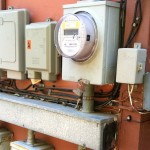For Texas Electricity Customers, Here Comes the Sun

Photo by ANDREAS SOLARO/AFP/GettyImages
French Erwann Le Rouzic, captain of Planetsolar catamaran, the first boat around the world with solar energy, walks over the photovoltaic panel during his 581st day of sailing around the world, in the Mediterranean Sea near Corsica on May 1, 2012 .
While Texas leads the nation in the production of oil, natural gas and wind energy, the sunny state is lagging a little in the solar energy race. Texas comes seventh in installed solar, but ranks first in potential for solar energy. Several new developments in the state’s energy industry may begin to change that.
If you’re a customer in the deregulated parts of Texas’ energy market (i.e. most of the state, save Austin, El Paso, San Antonio, and some parts of the Panhandle), you now have the option to to power your home 100% from the sun. SolarSPARC is a new program from a retail electric provider — essentially the cable or phone companies of the electricity world in Texas — that is offering, for the first time, a 100% solar power option for customers.
“This really opens up solar to the masses,” says Shay Ohrel, product innovation manager for Green Mountain Energy in Austin, which has started the program. “It allows people to receive both the environmental and financial benefits of solar.”
Solar continues to get cheaper, and installations are growing in the country. While Texas doesn’t have much of it yet, cities like Austin and San Antonio are moving forward with long-term projects to build large solar farms. An option like Solar Spark allows residential consumers outside of those cities to choose solar without having to install panels on their own roof.
But the company will have to go out of the state to get the solar, as Texas doesn’t have enough to supply anticipated demand. (Most of the large solar projects in Texas belong to the cities of Austin and San Antonio.) For the time being, the company plans to use renewable energy certificates (basically, solar credits) to make the plan 100% solar. “Once energy is on the grid, you can’t distinguish between green electrons and brown electrons,” says Ohrel. “So what we’re doing is, we’re pairing 100% of a customer’s load [how much energy they use] with solar renewable energy certificates.” As the Environmental Protection Agency explains on its website, “the renewable energy certificate product is what conveys the attributes and benefits of the renewable electricity, not the electricity itself.” It’s the same system that allows Google to “power” its servers with wind energy, even if there isn’t a breeze.
The plan will cost more than other options available in the retail market. The company expects to charge around 12 cents per kilowatt-hour. By comparison, some traditional retail plans available in Texas cost about half that.
The company has also committed to building solar projects in Texas every six months. How much exactly depends on how many customers sign up and use the plan, Ohrel says, and for every new solar project funded, customers will receive an $11 credit. The first of those is already under way, at the Green Mountain wind farm in Howard County in West Texas.
“There’s a very unique, symbiotic relationship between West Texas wind and solar,” says Ohrel. Since wind blows mostly at night in the region, and the sun shines during the day, the two complement each other as renewable resources, Ohrel says.
“We’ve been working on wind and solar now for decades,” Roger Duncan, a research associate at the University of Texas at Austin and former head of Austin’s energy utility, said earlier this year. “And it is really starting to take off.”
Duncan predicts a bright future for solar in Texas and the rest of the country, but cautions that it will take time to get there. “I don’t think you’re going to see the majority of our electricity come from renewable energy in the next ten years,” Duncan says. “Fossil fuels are still relatively cheap. And I think they’re going to stay that way over the next few years. It takes time and money to put in the infrastructure and completely change the trillion-dollar fossil fuel infrastructure to renewable energy. That’s very, very difficult to do in a short time.”

